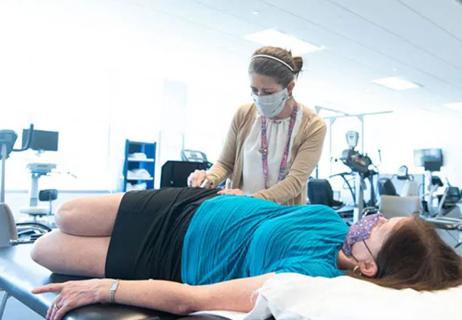Get ready for central vein sign and optical coherence tomography
Since 2000, multiple sclerosis (MS) treatments have multiplied, making earlier diagnosis and closer patient monitoring more important than ever. Relying on standard MRI and checking patients’ reflexes may no longer be enough.
Cleveland Clinic is a non-profit academic medical center. Advertising on our site helps support our mission. We do not endorse non-Cleveland Clinic products or services. Policy
“The activities we do during a clinic visit or over the course of following a patient with MS must evolve with the therapeutic options we have,” says Robert Bermel, MD, Director of Cleveland Clinic’s Mellen Center for Multiple Sclerosis Treatment and Research.
In the newest episode of Cleveland Clinic’s Neuro Pathways podcast, Dr. Bermel discusses technologies that are emerging to meet these needs, such as using the central vein sign to differentiate MS white spots on MRI and using optical coherence tomography to detect degeneration in retinal nerve fibers.
The audio interview also touches on:
Click the player below to listen to the podcast now, or read on for a short edited excerpt. Check out more Neuro Pathways episodes at clevelandclinic.org/neuropodcast or wherever you get your podcasts.
Dr. Bermel: We’ve all encountered the problem of patients who present with white spots on their brain MRI scan and trying to determine if these white spots are consistent with MS or if they are less-specific white spots that we sometimes see in patients with microvascular disease or migraine headaches. We’re hopeful that a new technique called the central vein sign might help differentiate white spots.
The central vein sign is rooted in something we’ve known for a long time — MS lesions tend to be perivenular. Now there’s been development of an MRI technique that can be done at 3 tesla, which is a large percentage of the clinical scanners out there these days, and doesn’t add much scan time. There’s an initiative through the North American Imaging in Multiple Sclerosis (NAIMS) Cooperative, of which we’re a part, to validate the central vein sign so radiologists or neurologists can look at these images and classify whether a large percentage of a patient’s white matter lesions have a central vein associated with them. That could enter into diagnostic help when trying to differentiate MS from non-MS white spots.
There’s another technique that we’re hoping to get into the diagnostic realm, an eye scan called optical coherence tomography (OCT). Neurologists have used visual evoked potentials for a long time to substantiate a prior optic neuropathy in a patient. It would be really nice if we had a technique that’s even more accessible to neurologists, something called OCT. There’s a collaborative called IMSVISUAL, of which we’re a part, working on validating retinal nerve fiber layer loss as a surrogate for prior optic neuritis.
These are things that MS neurologists will become familiar with in the future. Even general neurologists could have some access to these techniques through subspecialists. If you have radiologists that you work with, central vein sign might be something that they could use. If you have neuro-ophthalmologists that you refer to or work with, being familiar with OCT and getting those results might be really useful.

Q&A with Brain Trauma Foundation guideline architect Gregory Hawryluk, MD, PhD

Q&A with newly arrived autoimmune neurology specialist Amy Kunchok, MD

A neurocritical care specialist shares what’s spurring growth of this new evaluation approach

Focused ultrasound offers a newer alternative to deep brain stimulation

Prehabilitation can help improve outcomes after spine surgery

How these new drugs fit into practice two years out from their first approvals

A conversation on the state of physiatry with the AAPM&R’s Vice President

Pharmacologic, procedural and surgical treatments abound